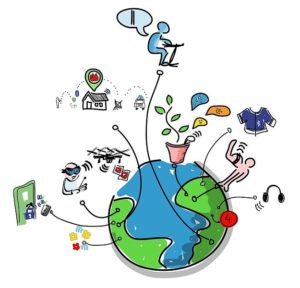What is Internet of Things?
Considering we all know about internet, before we go in to Internet of Things let me give a short note on What is internet.
By definition Internet is the global system of interconnected computer networks that use the Internet protocol suite (TCP/IP) to link devices worldwide.
The term Internet is used to refer to the specific global system of interconnected devices. In simple definition of internet, we can say the Internet can be defined as the mode of communication through which one can receive, transmit information between multiple devices (Things) that can be used for multiple operations.
The things can be physical devices, vehicles, home appliances, electronic devices, sensors, actuators, software etc. which can be connected & exchange data.
Now i think we should be able to answer for what is iot.
IoT meaning or IoT full form : Internet of Things.
The Internet of Things (IoT) is the network of things (physical devices, vehicles, home appliances, and other items embedded with electronics, software, sensors, actuators) connected through internet which enables these things to exchange data. This creates opportunities for more direct integration of the physical world into computer-based systems, resulting in efficiency improvements, economic benefits, and reduced human exertions.
In simple terms we can say IoT is a system of things integrated with sensors, softwares, electronics which are connected to each other & can exchange data or Information with other connected devices.
How IoT works:
If you do a google search you may notice lot of articles however if still not able to understand the IoT basics, let me give you a short explanation.
The main pillars of IoT projects or IoT solutions are
- Sensors/Devices
Sample sensors are below
- Connectivity
ESP8266 Wifi module is a sample connectivity device
- Data Processing
Data processing is done mainly in cloud , using data analytics tools.
The Sensors & devices can be like temperature sensor, motion sensor, camera, GPS etc. and to connect these devices each others there should be a medium like Internet ( WiFi) , Bluetooth, satellite, Cellular etc. And last the data send between the devices need to be stored & analyzed like in cloud, data analytics software etc.
There can be optional user interface also be part of it in through which useful information can be viewed, monitored, alerts can be set etc.
The number of IoT devices increased 31% year-over-year to 8.4 billion in 2017 and it is estimated that there will be 30 billion devices by 2020
Connectivity or network is the crucial technology for IoT, there are several wired & wireless technologies available now
- Short range wireless communication
Bluetooth, wireless, Radio frequency, Z-wave, Zigbee
- Medium range wireless communication
LTE advanced, Halow
- Long range wireless communication
Long range wireless, satellite
- Wired
Ethernet, power line communication
The challenges on IoT is more related to security & data sources, different regions & governments have laws for data protection. How your IoT devices can embed the law & regulations when you make your IoT solutions.
According to the Business Insider Intelligence Survey conducted in the last quarter of 2014, 39% of the respondents said that security is the biggest concern in adopting Internet of things technology.
As IoT are growing, we are talking about more connected machines & the probability of cyber attacks are more.
The IoT soultions are spread across wide areas and some are listed below
- Smart Home
IoT devices part of home automations like lighting, temperature control, air conditioning, security systems etc.
- Enterprise applications
IoT devices used in corporate & business
- Infrastructure applications
Monitoring & controlling of infrastructure like bridges, railways, roads, traffic etc.
- Manufacturing
Integration in manufacturing area with sensors for identification, communication, tracking etc is improving the efficiency of manufacturing area. Example like opening the door automatically when truck comes.
- Agriculture
There are numerous IoT applications in farming such as collecting data on temperature, rainfall, humidity, wind speed, pest infestation, and soil content. This data can be used to automate farming techniques, take informed decisions to improve quality and quantity, minimize risk and waste, and reduce effort required to manage crops.
- Environmental monitoring
IoT solutions for environmental protection , monitoring rivers, water quality , forest area etc.
- Energy Monitoring
Lot of power sources can be connected & can communicate each other for better utilization of power.
- Medical & Healthcare
IoT devices for health monitorings & other activities in hospitals, health centers.
One of the key drivers of the IoT is data. The success of the idea of connecting devices to make them more efficient is dependent upon access to and storage & processing of data. For this purpose, companies working on IoT collect data from multiple sources and store it in their cloud network for further processing. This leaves the door wide open for privacy and security dangers and single point vulnerability of multiple systems . This brings up the points on government regulations on data protection, this varies from country to country.
i will be covering the details on IoT Platform in my coming blogs.
Reference IoT Wiki : https://en.wikipedia.org/wiki/Internet_of_things
